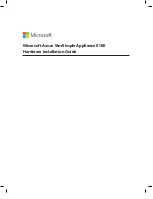
pulsAR
radio Operator's Manual
udp-configuration
console=on
or
off
vital-port-1=1..0xFFFF
vital-port-2=1..0xFFFF
command-port=1..0xFFFF
max-response-bytes=400..65521
socket-mode=1
or
2
peer-address=<ip address>
peer-command-port=1..0xFFFF
The
console
parameter turns
on
or
off
the radio UDP interface. The factory default is off. You
may turn it on for either of the following purposes:
1.To send and receive
vital packets
which the radio classifies as the highest priority (see
section 2.5.2).
2.Send radio configuration text commands encapsulated in UDP/IP packets. This is useful
when you want to configure the radio from a program running on an external computer
The
vital-port-1
and
vital-port-2
specify two different UDP port numbers. The radio examines
the “source” and “destination” ports of any UDP encapsulated packets that the radio receives
and queues for transmission over RF. If any of those two values match the vital-port-1 or vital-
port-2, the packet is classified as
vital priority
and is transmitted ahead of all other packets.
All the remaining parameters are used for the purposes of issuing radio commands using UDP
encapsulated packets. The formats of these UDP packets and radio replies are described in
detail in section 5.3.
The
command-port
parameter is the UDP port number used by the radio to receive commands.
The
max-response-bytes
parameter limits the length of the response packets generated by the
radio. If the response is longer than this value it gets truncated.
The
socket-mode=1
(default) is intended for applications where the controlling program
allocates a single socket for packets in both directions, while
socket-mode=2
is used when the
program must create separate sockets for sending to the radio and receiving from the radio.
In both modes the radio listens for UDP packets addressed to the specified
command-port
number. In
socket-mode 1
, if you do not specify a
peer-address
and a
peer-command-port
the radio accepts packets from any IP address and port and sends the responses to the same IP
address and port from which the command was received. If you specify a
peer-address
and/or
a
peer-command-port
the incoming packets must match these parameters, otherwise the
packets will be ignored.
In
socket-mode 2
, the radio sends the UDP command replies to the IP address specified by the
peer-address
parameter and sets the destination UDP port to the value specified by the
peer-
command-port
parameter. Additionally the IP address on incoming packets must match the
peer-address
parameter.
4.6 Installation and Link Monitoring Commands
These commands are useful as installation aids and also for monitoring link statistics after the link is
established.
4-15
Summary of Contents for AR-24010E
Page 2: ......
Page 74: ...pulsAR radio Operator s Manual 4 26 ...
Page 96: ...pulsAR radio Operator s Manual B 2 ...
















































